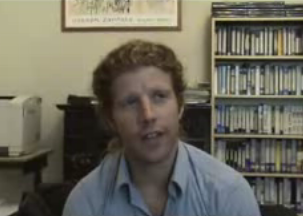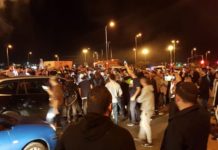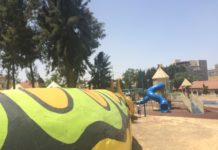Noam Bedein (26) lives in Sdeirot. He majored in human resources in Sapir
College. Recently he has devoted all of his time to an international publicity
campaign within the framework of a media center which he established in Sdeirot.
He is a recognized newspaper photographer, and he has shown his work in many
photography exhibitions on topics of social interest.
Q: How did your personal experience lead you into becoming involved with
publicity for the good of Israel?
A: To tell the truth, I was sure that this would be the last thing I would ever
do in my professional life. I moved to Sdeirot three years ago, and the
experience of the Qassam rockets is what brought out my skills in this matter.
One Friday night I was sitting in a synagogue, and in the middle of the prayers
a “Red Alert” siren sounded. Half the congregants ran away in order to take
cover and to check on their fami
lies and homes. Fathers took hold of their
children and hugged them close to protect them. Fifteen seconds later, there was
a very loud explosion near the synagogue. This was the first time I expressed
myself in this way – I sat down and wrote an article which was then published in
the Jerusalem Post. The reality of Sdeirot is what pushed me into the area of
explaining our position.
Q: We are having this interview right before you take a trip to the United
States for a speaking tour. How do you portray us there?
A: I spend quite a lot of time abroad, mostly on campuses, where I speak to
students about Israel. As far as I am concerned, the personal story is the best
weapon that a publicist can use. Any experience that you can pass on to the
listener, especially if it touches his heart, will mold his outlook and will
therefore have an effect on public opinion. As a newspaper photographer I have
four different photographic exhibitions from which I choose in order to
correspond to the target audience. I am now preparing an exhibition which shows
Jewish symbols in the shadow of terrorism: Shabbat candles, Kiddush cups,
Chanukah menorahs, and holy objects, all of which were removed from within
demolished buildings.
I tell people how it is to ride into Sdeirot. At the entrance to the city, you
open the windows and release the safety belts, turn the radio off, and20pay
strict attention in order to hear any sirens. Recently a woman told me that she
had experienced an ethical dilemma: When a “Red Alert” sounded, she had to
choose which child to take out of the car in order to run for safety in a
shelter. Here are other examples: taking a shower very quickly, dogs that bark a
few seconds before the alarms sound, and families which never go onto the upper
floor of their home because it has not been reinforced.
Q: Why did you choose this city as the site for the “Sdeirot Media Center”?
A: When I arrived in the city, I discovered that there was no institution,
either private or public, which tells the personal stories of Sdeirot to the
world. It is important to realize that from a global perspective the town of
Sdeirot is unique. It is the only place in the world where rockets are regularly
fired at normal citizens. At the time there was nobody who passed this
information on to the world, and I therefore founded the center, in order to
influence the Israeli and worldwide public opinion.
This is a private center which today works with all the formal institutions in
the country, such as the Foreign Ministry and the Jewish Agency. The center
serves students and mainly diplomats. Our website gathers information about the
subjects that interest us, and we get about ten thousand visits a day from all
over the world. We prepared an
“Information Packet” about Sdeirot which was
distributed to every Israeli diplomatic office in the world. In my opinion, a
private institution can be much more effective than a public one, which is
treated as such by the world media. Life experiences are much better than dozens
of “dry” statistics.
Q: How do you look at us, the Israelis, from the center of Sdeirot?
A: Until recently, the radio reports about Qassams falling on Sdeirot, where
“nobody was injured and there was no damage,” were tacked on at the end of the
broadcasts, right before the weather. The psychological and human aspects of the
attacks were never mentioned. The people in the center of the country have no
idea what is happening outside of their quiet bubble. In Sdeirot, one lives in
fear even if no physical damage was caused.
Last year I toured the campuses in Israel and I discovered a deep lack of
knowledge. People simply do not know that Sdeirot is a mere 45 minutes away from
Tel Aviv. It was quite a challenge to make people wake up and relate to the
reality.
Q: Is there any way to fight against the Palestinian pictures of atrocities?
A: I am absolutely sure that there is! The demonstrations against Israel all
over the world are the fruits of labors by the Palestinian propagandists, who
have invested millions of dollars in order to disseminate their personal stories
in=2
0the world media. Twenty years ago or more, they identified the potential use
of personal publicity and began to invest their money in it, and in this way
they have managed to influence the public opinion in the world.
For example, in the beginning of March 2008, 365 rockets were fired at Israel.
The IDF responded with a military action in Beit-Chanun and killed some
terrorists. The Palestinian propaganda reacted with a media campaign that
contained dozens of “colorful” pictures of the injured. The headlines in the
media the next day are what prevented the IDF from continuing the operation. I
invited the bureau chief of the New York Times to come to the center in Sdeirot,
and as a result he wrote a front-page story about the life of one of the
families here. And that is one more example of how a personal story can be used
to fight against Palestinian propaganda.











